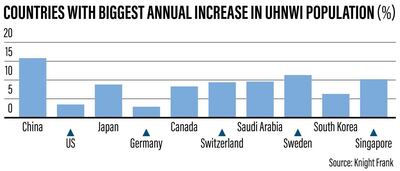The number of ultra-high-net-worth individuals in the Middle East is projected to increase 24.6 per cent in the next five years, according to a new report by global property consultancy Knight Frank. The region will remain the fourth-largest wealth hub in the world.
The global population of the ultra-wealthy is forecast to rise 27 per cent over the same period to almost 663,483 from 513,244 in 2019, according to the consultancy's 2021 Wealth Report.
Knight Frank defines HNWIs as those who possess a net wealth of $1 million or more (including primary residences and second homes not held as investments), while UHNWIs have a net wealth of $30m or more.

Asia is likely to see the largest rise in the number of UHNWIs with growth of 39 per cent, led by Indonesia and India, the report said. By 2025, 24 per cent of all UHNWIs will live in Asia. The region is already home to the most billionaires, accounting for 36 per cent of the global total.
Over the next five years, Africa is estimated to have the second-highest growth in UHNWIs at 33 per cent, led by Zambia (40 per cent) and South Africa (32 per cent).
Over the same period, the number of millionaires globally is set to rise by 41 per cent, the consultancy added.
“The pandemic has impacted the fortunes of many in the Middle East, and HNWIs and UHNWIs were not spared, with the total number of each decreasing by 11.3 per cent and 10.1 per cent, respectively, in 2020,” Taimur Khan, head of research at Knight Frank Middle East, said. “However, this decline was not uniform across all countries.”

In Saudi Arabia, the number of UHNWIs over this period increased by 9.6 per cent. In fact, the kingdom’s UHNWI population has grown by 227 per cent over the past five years, according to Knight Frank.
“As the region continues its various economic diversification programmes, we expect that there will continue to be significant growth in the number of HNWI, UHNWI and billionaires residing in the region,” Mr Khan added.
This was also reflected in the results of the Knight Frank Attitudes Survey conducted among private bankers and wealth advisers in the Middle East, where 67 per cent of respondents said their clients' wealth either remained the same or increased. Around 69 per cent expect their clients' total wealth to increase in 2021.
Meanwhile, 31 per cent of UHNWIs in the Middle East plan to purchase a property in 2021. This compares with 26 per cent of UHNWIs globally who are planning to buy a new home this year. The top choices for Middle East buyers are the UK, US, Turkey, Spain and the UAE, according to the Wealth Report.
While Auckland leads Knight Frank's Prime International Residential Index with price increases of 18 per cent last year, weaker economic conditions and oversupply in the GCC resulted in a decline in prime property prices in Doha (6 per cent), Dubai (5.9 per cent) and Riyadh (3.3 per cent). Prices in Abu Dhabi's prime market remained stable.
"While Dubai's prime residential market saw prices decrease by 5.9 per cent in the year to November 2020, we are beginning to see signs of a recovery in price performance in some prime sub-markets," Mr Khan said.
The Wealth Report also includes Knight Frank's City Wealth Index. London and New York ranked joint first on the index as the most important cities for UHNWIs to live, invest and do business. Paris follows in third position, while Tokyo and Hong Kong round out the top five spots.
In the wealth category, which measures the number of UHNWI and HNWI city dwellers, New York ranks first globally with 7,743 individuals. However, when looking at the number of HNWIs, London comes first with more than 870,000 millionaires, according to Knight Frank.
Despite the Covid-19 pandemic, private capital worth $232bn was invested in commercial real estate globally last year, Knight Frank said. The US ($141.7bn), Germany ($11.1bn) and the UK ($10.6bn) were the top three countries for private capital real estate investments in 2020.
Around 23 per cent of UHNWIs in the Middle East plan to invest in commercial real estate assets in 2021. Logistics, residential, healthcare and data centres are set to generate the most interest, it added.
London saw the highest level of cross-border private capital ($4bn) invested in commercial real estate over the 12 months to September 2020. The city also claimed the top spot for the largest number of homes considered “prime” within a city, with more than 68,000 homes worth £2m ($2.8m) or more. Dubai ranked second (42,356 homes) and Sydney (27,436 homes) was in third place.
“Given the established appeal of London as a cultural and business hub, ease of language, attractive educational system and weaker pound in recent years, we see Middle Eastern demand for prime London homes continuing in future years,” Henry Faun, partner with Knight Frank private office in the Middle East, said.








